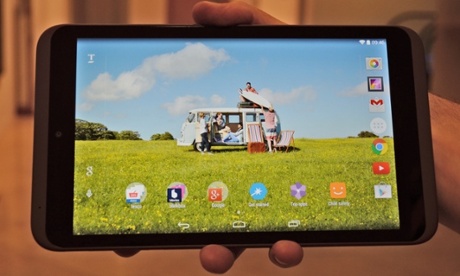
Tesco’s group digital officer declined to say whether the supermarket chain will shut down its loss-making Blinkbox media service, as it launched a revamped version of its Hudl tablet.
Michael Comish, formerly Blinkbox’s chief executive, positioned the new, larger-screened Hudl 2 as an important element of Tesco’s digital strategy, saying that owners were more likely to use both Blinkbox and Tesco’s online shopping service – though he declined to say how much more.
But independent analysts suggest that Tesco’s tablet strategy could even be Blinkbox’s saviour as Tesco uses the branded devices to combat online retailers such as Amazon by pushing its own video, music and book services, and in-store offers. “The Hudl is probably one of the best ways for Tesco to push its own services and boost revenues in the long term,” said Francisco Jeronimo, smartphones and tablets analyst for researchers IDC. Ben Wood, head of research at CCS Insight, said “they have to be looking over their shoulder at Amazon, and they need technology hooks to move the wider business forward.”
However Blinkbox’s future is still unclear. Media reports say the streaming film, music and books business, bought by Tesco in April 2011 to challenge Amazon’s LoveFilm, music and ebook services, could be shut or sold under a strategic review as Tesco’s new chief executive wrestles with a £250m overestimate of its first-half profits.
Comish said on Friday that he was “well aware of press speculation” about Blinkbox’s fate but said that there “are some very good reasons I am not going to add to the speculation today.” The services were all still there and “hugely accessible”, he said.
Blinkbox, which offers film, music and ebook download and streaming services, is part of a competitive market where it is up against multiple players including Sky, Amazon, Netflix, Apple, Spotify and Deezer.
Latest figures filed at Companies House show that in the year to February 2013 Blinkbox had revenues of £3.2m, up from £2.3m a year before, and made an operating loss of £17.97m - dramatically widened from a £5.56m loss the year before.
But the Hudl could be vital to a longer-term strategy in which Tesco fends off online retailers, particularly Amazon, which has launched its own range of tablets and a smartphone with subsidised offers to video and goods deliveries.
Comish said that the Hudl should be seen as part of a wider strategy from Tesco. “You have to see the product in the round,” he said. “It’s part of the Tesco offering. But we’re not controlling our customers. We’re not forcing you to watch ads when you use it” - a swipe at Amazon, which advertises films and books on the front screen of its Fire tablets.
According to eMarketer, there are roughly 24.6m tablets in use in the UK, of which around half are Apple’s iPad, with Samsung the second-largest, followed by a number of smaller vendors which like Tesco use Google’s Android software. Deloitte reckons about 13m tablets were sold in the UK in 2013.
Tesco says it sold 750,000 of the first version of the Hudl, released in September 2013; that suggests that sales slowed after a strong Christmas, when it sold 400,000 in its first three months.
At its selling price of £120 the Hudl generated roughly £90m of direct revenue, over a period during which Tesco’s UK revenues alone were roughly £2.2bn. Comish forecast that the new Hudl 2 would sell at least as well.
But Comish insisted that the new Hudl 2, which also has a Tesco-built app to let parents control childrens’ use of apps and websites, would see strong sales: “We see the tablet market expanding,” he said. “Growth might go from exponential to linear, but we expect double-digit [above 10%] growth.”
Jeronimo said that the Hudl 2 was priced in one of the fastest-growing segments of the tablet market: “While the overall tablet market in the UK shrank in the second quarter of 2014, shipments of tablets at the £70-£80 price grew by 52% from the previous year. That’s the price point that’s driving sales.”
Wood said that the Hudl range could be important for loyal Tesco customers who are driven by coupon offers and Clubcard incentives: “On paper there might be a question of whether it’s worth doing, but Tesco needs this as a web player and as a brand. It keeps it contemporary and shows a joint approach to the physical and digital space.”

